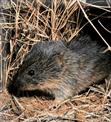Prairie Vole (Microtus ochrogaster) - Wiki Prairie Vole
From Wikipedia, the free encyclopedia
Order: Rodentia
Family: Cricetidae
Synonyms
- Arvicola austerus LeConte, 1853
- Hypudaeus ochrogaster Wagner, 1842
- Microtus ludovicianus V. Bailey, 1900
[Photo] Prairie Vole (Microtus ochrogaster). Source: Tallgrass Prairie National Preserve (www.nps.gov/tapr/naturescience/animals-at-the-preserve.htm). Author: United States National Park Service.
The Prairie Vole (Microtus ochrogaster) is a small vole found in central North America.
The vole has long, coarse grayish-brown fur on the upper portion of the body and yellowish fur on the lower portion of the body. They have short ears and a short tail, which is somewhat darker on top. Prairie voles are 15 cm long with a 3 cm tail and weigh about 67 g.
Taxonomy and distribution
The prairie vole's scientific name, Microtus ochrogaster, is derived from Greek; the genus name translates to "small ear" and the specific epithet translates to "yellow belly". They are found in grasslands in the central United States; ranging from the eastern Rocky Mountains in the west to West Virginia in the east and into the Canadian Prairies to the north.
Habitat
Prairie voles make shallow underground burrows and runways through surface vegetation. In winter, they tunnel underneath the snow. Their runways are used for many purposes, from predator protection to obtaining food. Prairie voles are easily disturbed. They will not hesitate to use their underground burrows if they notice predators close by or disturbances that pose a threat. Compared to the meadow vole, prairie voles prefer to inhabit drier areas.
Behavior
Prairie voles are active year-round. In colder weather, they tend to be more active during the day; at other times, they are mainly nocturnal. Prairie voles live in colonies and have been known to exhibit human-like social behavior in groups.
Prairie voles live rarely longer than one or two years. Their life expectancy is base on predator presence and natural factors in their area of inhabitance.
Prairie voles are primarily herbivorous, feeding on grasses, roots, fruit, seeds and bark and some insects. The voles store food. Predators include coyotes, hawks, owls, foxes and snakes. They may cause damage to garden plants and small trees.
Reproduction
During mating season, prairie voles take up individual territory and defend it from other voles. They mark their territory with urine and other secretions. A posture that the defender use towards a competitor or enemy is raising the forefeet, extending the head forward, and chattering of the teeth. During non-mating seasons, the prairie voles live together.
Like other voles, prairie voles can reproduce at any time of the year, but the main breeding seasons are in the fall and the spring. Unlike other voles, prairie voles are monogamous. The prairie vole is a notable animal model for sexual fidelity, since the male is usually faithful to the female, and shares in the raising of pups. There have been studies that support that not all prairie voles are monogamous. Studies have also shown that females have offsprings that are from more than one male. The females will show aggression towards unfamiliar males, but do the opposite for a male that they are familiar with. The males also help clear away debris from the underground runaways.
The female's gestation period is between 20 and 30 days. Female voles have two to four litters of 2 to 7 young per year in a nest lined with vegetation in an underground burrow or in a depression on the ground. Litter size varies depending on food availability and the age of the female. Baby voles open their eyes at about eight days after birth, become capable of feeding themselves at about two weeks.
Interaction with humans
Prairie voles can damage plants in gardens, lawns and farmlands. They are considered pests in these areas. The presence of voles is typified by small holes leading underground.
Vole prevention and eradication
There are many ways to prevent voles from destroying gardens or other areas. Poisons, traps, electric repellers, and predators (snakes, owls, coyotes, foxes, domestic animals, and hawks) can be used to reduce vole populations. Voles can also be scared away by plastic ornaments that resemble natural predators. Some farmers though, are using prairie voles as a food source for other animals instead of poisoning the voles.
Though poison is an option to prevent voles, poisoned voles can create a threat to other animals and humans. Voles are prey for other predators. If they are eaten by predators while poisoned, the poison could harm the predator. In addition, when placing poison near vole entrances, other animals may be able to reach it making it a hazard to them. Not only that, by placing open poison in the field, the poison can easily be blown away by the wind, and also easily get washed away by rain. In residential areas, the poison itself and poisoned voles can be harmful and/or dangerous to people as well as domesticated animals.
http://en.wikipedia.org/wiki/Prairie_Vole
| The text in this page is based on the copyrighted Wikipedia article shown in above URL. It is used under the GNU Free Documentation License. You may redistribute it, verbatim or modified, providing that you comply with the terms of the GFDL. |
